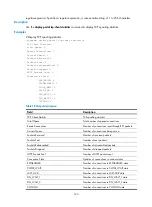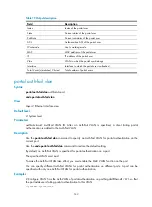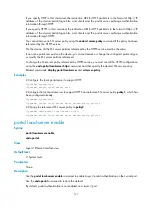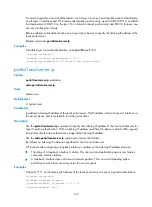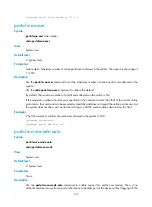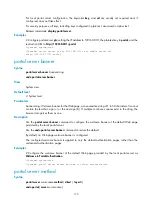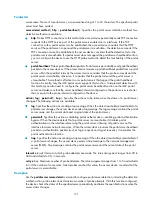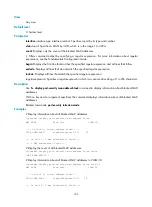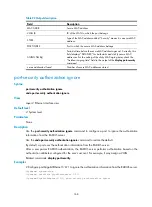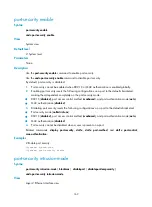
154
portal server
Syntax
portal server
server-name
{
ip
ipv4-address
[
key
[
cipher
|
simple
]
key-string
|
port
port-id
|
url
url-string
] * |
ipv6
ipv6-address
[
key
[
cipher
|
simple
]
key-string
|
port
port-id
|
url
url-string
] * }
undo portal server
server-name
[
key
|
port
|
url
]
View
System view
Default level
2: System level
Parameters
server-name
: Specifies the name of a portal server, a case-sensitive string of 1 to 32 characters.
ip
ipv4-address
: Specifies the IPv4 address of a portal server. .
ipv6
ipv6-address
: Specifies the IPv6 address of a portal server.
key
: Specifies a shared key for communication with the portal server. Portal packets exchanged between
the access device and the portal server carry an authenticator, which is generated with the shared key.
The receiver uses the authenticator to check the correctness of the received portal packets.
cipher
: Sets a ciphertext shared key.
simple
: Sets a plaintext shared key.
key-string
: Specifies the shared key. This argument is case sensitive. If
simple
is specified, it must be a
string of 1 to 16 characters. If
cipher
is specified, it must be a ciphertext string of 1 to 53 characters. If
neither
simple
nor
cipher
is specified, you set a plaintext shared key.
port
port-id
: Specifies the destination port number used when the device sends an unsolicited message
to the portal server, in the range of 1 to 65534. The default is 50100.
url
url-string
: Specifies the uniform resource locator (URL) to which HTTP packets are to be redirected. The
default URL is in the http://
ip-address
format, where
ip-address
is the IP address of the portal server. You
can also specify the domain name of the portal server, in which case you must use the
portal free-rule
command to configure the IP address of the DNS server as a portal authentication-free destination IP
address.
Description
Use the
portal server
command to configure a portal server for Layer 3 portal authentication.
Use the
undo portal server
command to remove a portal server, restore the default destination port and
default URL address, or delete the shared key.
By default, no portal server is configured for Layer 3 portal authentication.
If the specified portal server exists and no user is on the interfaces referencing the portal server, using the
undo portal server
server-name
command removes the specified portal server, and if keyword
port
, or
url
is also provided, the command restores the destination port number or URL address to the default.
The configured portal server and its parameters can be removed or modified only when the portal server
is not referenced by an interface. To remove or modify the settings of a portal server that has been
referenced by an interface, you must first remove the portal configuration on the interface by using the
undo portal
command.

